Last updated on January 12th, 2022
The Baroque Flower Garden of Kromeriz Castle (Zámek Kroměříž) in the Czech Republic (Czechia) is beautiful. But it’s not a UNESCO world heritage site just because it is beautiful – this garden captures the moment when gardens changed from intimate private spaces to elaborate public stages.
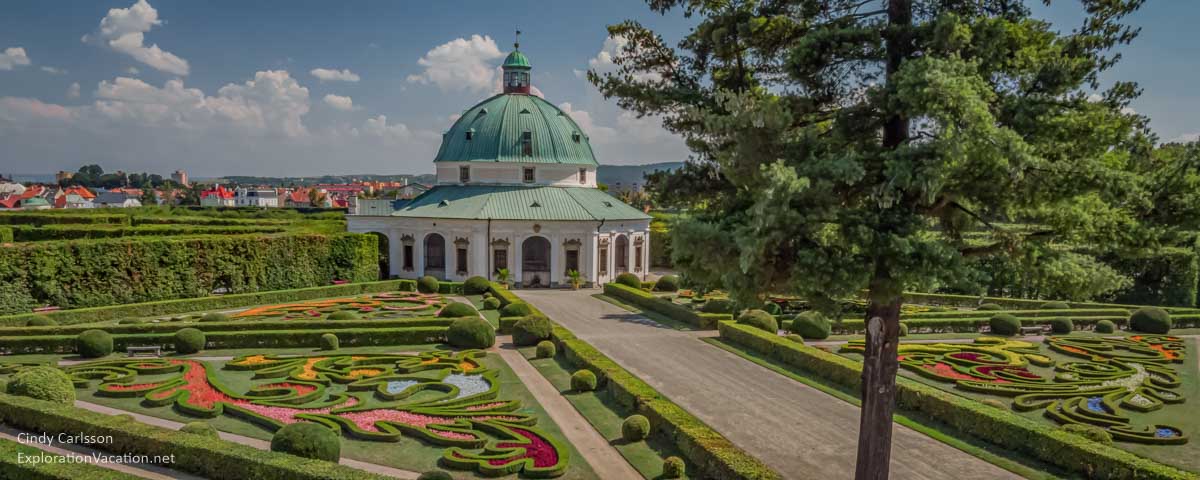
I provide links as a convenience to you. Some may be affiliate links that pay me a small commission if you use them to reserve a room or purchase goods or services. You don’t pay anything extra, but it helps keep this website running. All affiliate links are for products or services I personally use and recommend. To learn more, please review this website’s policies and disclosures.
I visited the Flower Garden in Kromeriz as a guest of Czech Tourism and the East-Moravian Tourist Authority, however, all opinions are strictly my own.
Stroll through the garden with me
Often called the Kromeriz Flower Garden, it’s more accurate to refer to this as the Pleasure Garden. While there are flowers, they are just the paint that adds a splash of color to carefully constructed patterns created from manicured shrubbery. These elaborate designs, along with the carefully aligned paths, fountains, and fanciful architecture, advertised the owner’s wealth and sophistication. They also made this the garden place for the local elite to be seen at the close of the 17th century.
Entering the garden
Today visitors enter the Flower Garden through a 19th century gate along one side. This gate was constructed as the public entrance when several greenhouses were added to display the estate’s plant collections.

At least one of the greenhouses flanking the entrance still has plants in it, but I didn’t have an opportunity to go in and see what the collection includes besides palms. The other greenhouse appears to serve as an event space with a small café.
The garden’s original entrance (through the center of a colonnade along the front of the garden) provided visitors with an immediate view of the formal Baroque garden. Entering by the greenhouses brings visitors into the functional part of the garden instead. There are decorative sculptures and fountains, but they enhance more prosaic plantings like herb gardens, orchards, and a small vineyard – remnants of the traditional kitchen garden that was once the focus of every garden.


The Flower Garden’s Baroque heart
Tall hedges and covered allées separate the various sections of the Kromeriz Flower Garden, so it was a bit of a surprise to pass through an opening in the greenery and suddenly find myself looking into the elaborate heart of the garden.
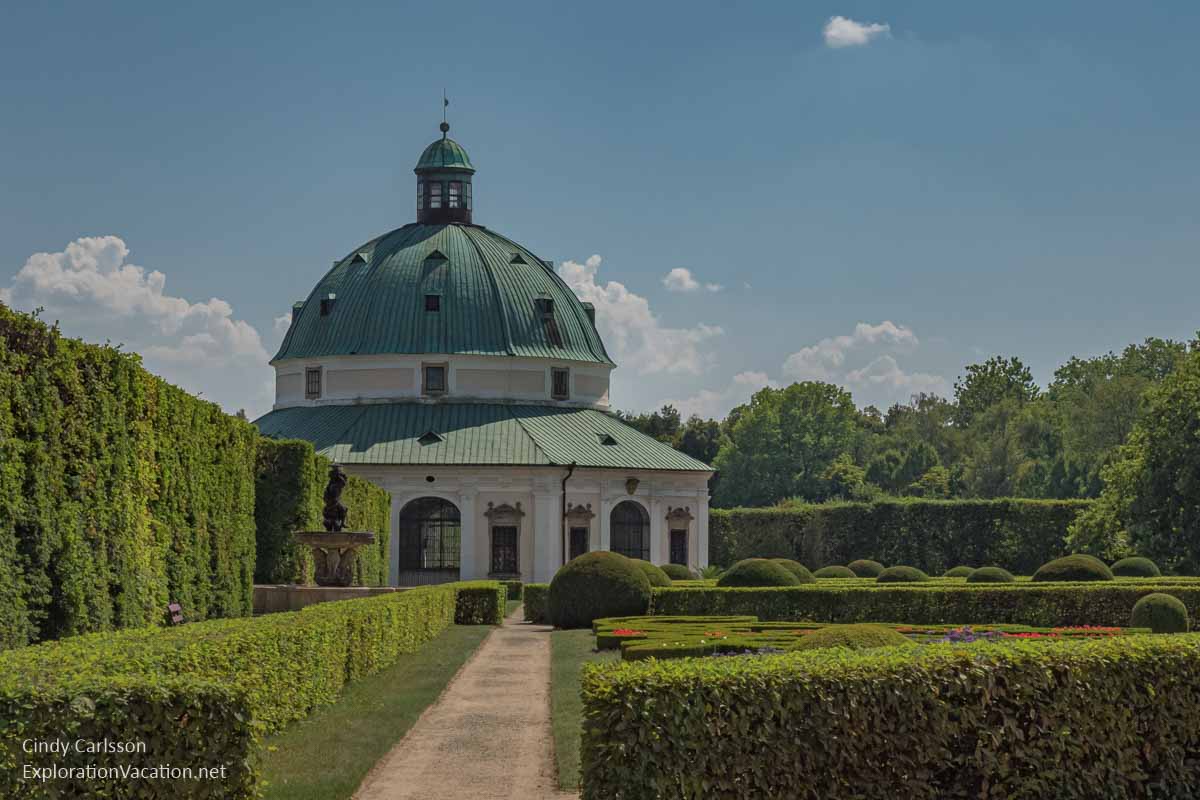
Entering the garden this way, layers of trimmed shrubbery dominate the view. The box hedges form rooms and within each room are more layers and patterns. At ground level, the colorful flowers for which the garden is named are barely visible above the clipped shrubbery!

Inside the colonnaded loggia
Fortunately, the Bishop of Olomouc Karl II von Liechtenstein-Castelcorno wanted visitors to fully appreciate the elaborate beauty of his garden. At the same time, he seems to have understood the value of panoramic views. (This was a new concept in 17th century gardens.) To ensure the garden’s mix of ridged geometry and swirling pattern was clearly visible, his Italian designers installed a colonnaded loggia with a raised viewing platform across the front of the garden.

Despite the delicate elegance of its arches, the loggia is massive. At 800 feet long (more than two American football fields) there is plenty of space for the 44 statues of gods and other figures from antiquity that are housed within. It’s also shady and cool inside, making it a great place to escape the blistering heat of midday even if heroic statuary of the ancients isn’t your thing. Just imagine the fancy gatherings of Kromeriz’s elite that must have been held here!

A look at the Flower Garden’s intricate geometric design
The original, rather inadequate stairway at one end of the loggia leads to the observation deck on top. From above, the huge viewing platform (the entire top of the loggia) provides everyone with sweeping views of the gardens below.
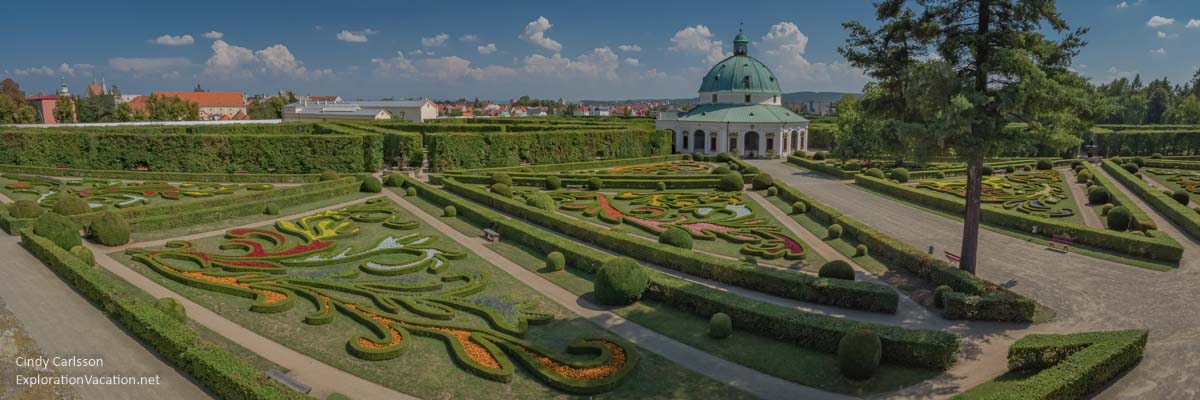
From this vantage point it’s relatively easy to see how the garden is put together.
The main garden consists of two squares, each of which is further subdivided into smaller squares.
Hedges of various heights break the gardens into “rooms” with intersecting pathways interrupted by fountains. The front half is the “flower garden” portion, where each square is further subdivided into triangular planting areas where swirling boarders of clipped hedges are filled with rather ordinary garden flowers to create colorful patterns. The Rotunda, a round folly sits in the center of it all. An essential piece of a Baroque garden, the Rotunda provides a focal point for the garden and another space for gathering.

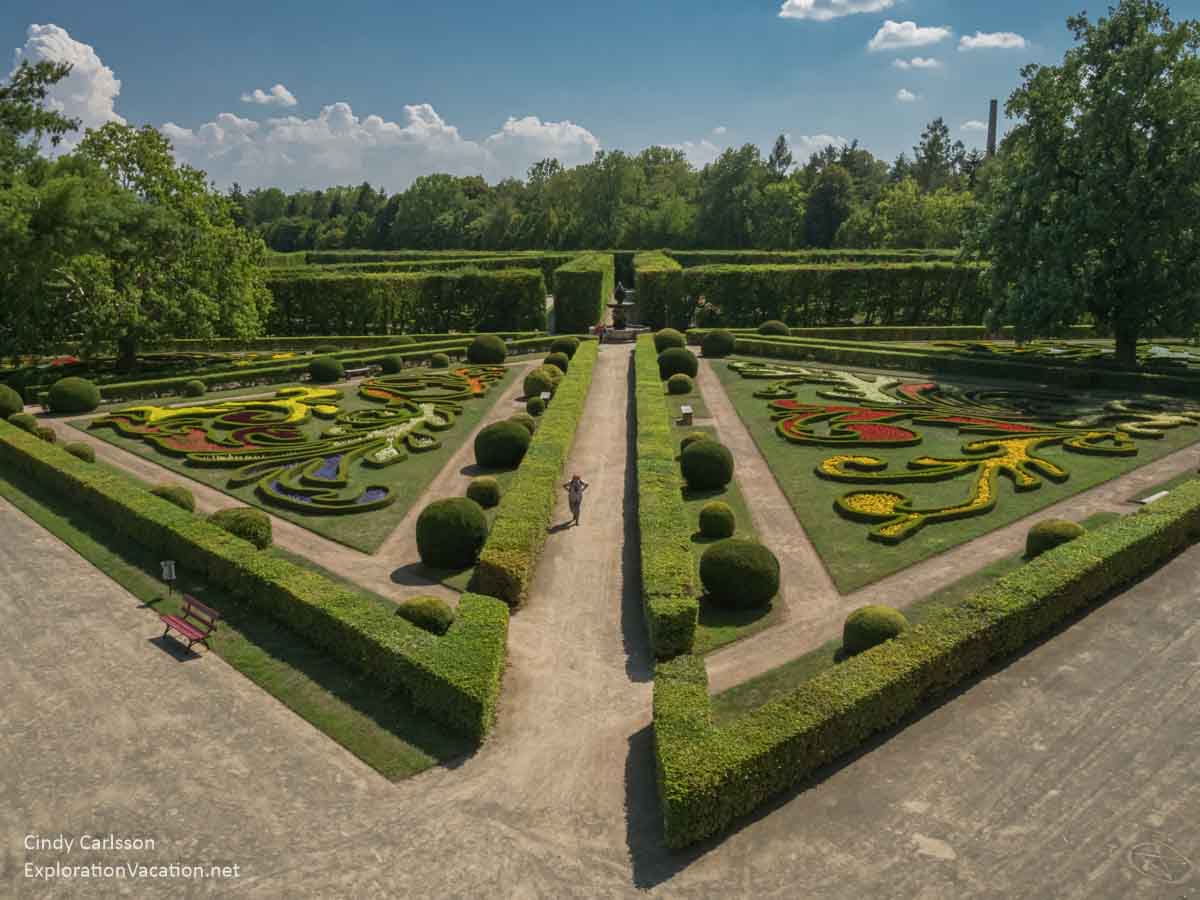
The back half of the garden isn’t really visible from the top of the loggia, but its design is simpler. The interlocking squares and triangles become less elaborate before giving way to a simple pattern with open lawn and orchards interrupted by a few allées, fountains, fish ponds, and sculpted hills.
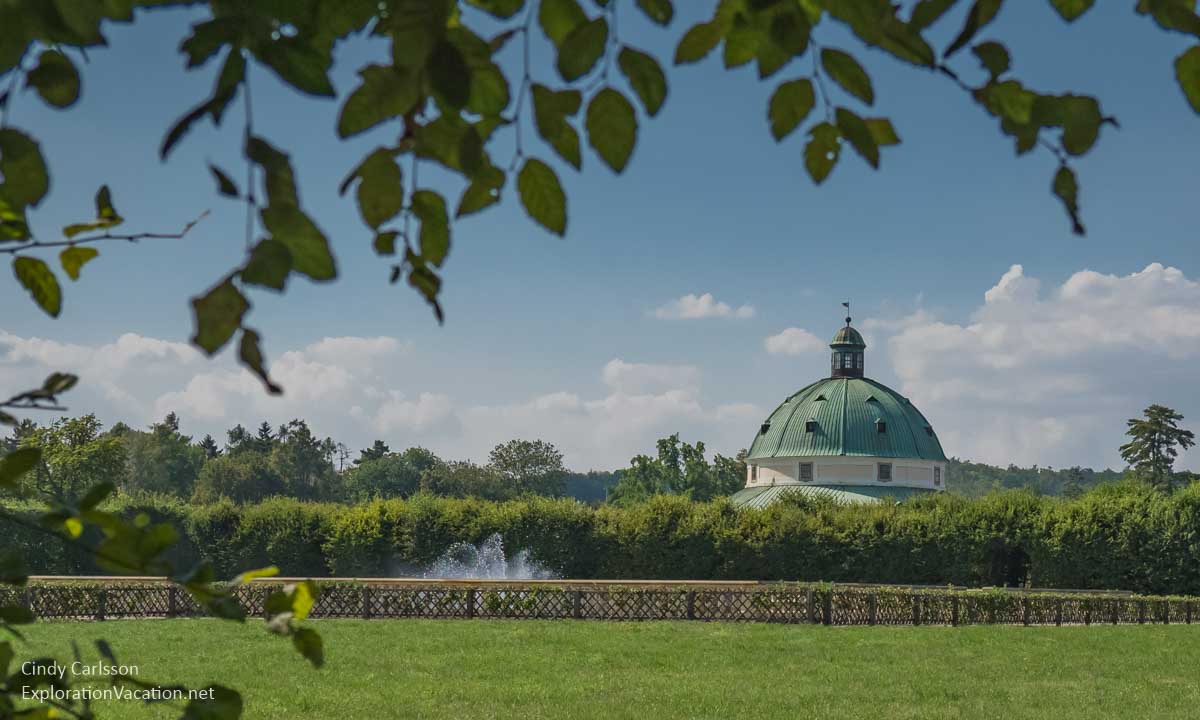
To the side, a pair of rectangular gardens (split by the greenhouses and entry gate) include the orchards, vineyard, and kitchen gardens I walked through when entering, as well as what appears to be a maintenance area with working greenhouses (all the annuals used in the gardens are grown on the property), another garden with a sculpted hill (this might be Rabbit Hill), and the aviary.
The Rotunda’s contrasting styles
Every Baroque garden needed an architectural focal point. Here in the Pleasure Garden, that focal point is the octagonal Italian Rotunda.
The Rotunda was open when I visited, so I got to explore inside a bit.
A Foucault pendulum (used to demonstrate the earth’s rotation) sits right inside the entry. This was not part of the Rotunda’s original furnishings since the first demonstration of the pendulum occurred almost 200 years after the gardens were completed. (Apparently it was added in 1908 and is one of only a very small number in existence.)
Stepping beyond the pendulum, the center of the Rotunda is a cheerful mix of elements. The floor includes twirling floral mosaics. Overhead, small windows, carved stucco, and colorful painted scenes with lots of putti flying around create a rather romantic atmosphere . . . even while it isn’t completely clear that all those painted nudes are involved in particularly romantic situations.

In stark contrast, dark grottos built into interior walls in the Rotunda are “tiled” with chunky fake shells and stones and feature grotesque statues of satyrs, Pan, and other creatures. Architecturally it doesn’t seem to fit with the rest of the structure at all.
The Rotunda underwent an “extensive reconstruction” in the 19th century, so it’s unclear to me how much of what remains is original. However, grottoes were popular in Baroque architecture and in the 17th century satyrs were popular figures representing revelry and amorous behavior. The grottoes in the Rotunda are also similar to some inside Kromeriz castle itself. Those were completed in the 1680s, leading me to believe that these were part of the original design.
In either case, I find the figures repulsive and can’t get beyond their earlier (and far stronger) association with drunkenness and rape. I suppose this was a great spot for a man to grab a forbidden kiss, but today I suspect I am not alone in finding these spaces forbidding, ugly, and more than a little creepy.
(It was too dark for me to get a decent picture, but you can look here and here to see a few examples.)
What makes this Czech garden special?
While the Kromeriz Flower Garden (or Pleasure Garden, as it is more properly known) is an excellent example of garden design as it moved from the Italian Renaissance into the French Baroque period.
Part of this change was in the very function of a garden. During the last half of the 17th century gardens began morphing from private spaces to public ones. Gardens became public displays of the owner’s wealth and sophistication as well as stage set for parties, theater, concerts, and other social activity. This lead to changes in both overall garden design and in the elements incorporated into the garden.
The Flower Garden in Kromeriz includes many features that became hallmarks of the Baroque garden design. These include its
- Large scale, sweeping vistas, and panoramic scenery
- Integration of architectural elements and nature
- Use of mathematical rules, strict geometry, and curved lines to create elaborate parterres
- Use of diagonal lines and converging axes to link components
- Extensive use of artificially trimmed plants and trees
- Focus on a centrally positioned
building - Use of water in fountains and basins
- Incorporation of classical sculpture and antiquities
The Kromeriz garden is also unique in that it is one of the few gardens from this time that survives largely intact. While it seems the garden suffered neglect over time, major changes were largely limited to a 19th century remodeling that added the greenhouses, reconstruction of the Rotunda, and made other changes in the garden’s design. A 1950s effort revitalized sections of the garden, but recent restoration work was intended to ensure the garden retains its historical appearance.
Visiting the archbishop’s gardens and chateau at Kromeriz
Kromeriz (spelled Kroměříž and pronounced something like Krom-yehr-zheesh) is a charming Moravian town in the eastern part of Czech Republic. It’s a very pleasant place and there is enough to see in the surrounding area (including the more well-known historic city of Olomouc) to make it a good stop for a day or two.
Getting to Kromeriz
If you have your own vehicle, getting to Kromeriz is easy. It’s trickier if you need to rely on public transit.
Visiting the garden
The Pleasure Garden is located on the west side of Kromeriz beyond the historic city core. The castle is on the east end of the historic core. There’s about a mile between the two.
Hours and admission
The Kromeriz Flower Garden is open daily except for major holidays. There is a small fee to enter. Opening hours vary slightly with the season. Guided tours are available. Check the website for specific information on hours, admissions, and fees for tours.
Other things to do in Kromeriz
Visitors to Kromeriz are usually there for the city’s UNESCO sites. However, this is an attractive town with a lot of interesting historic buildings around and beyond the central square. Because the Olomouc bishops had their residence here, the town attracted more grand buildings than one might otherwise expect. Most buildings (including some wonderful-looking churches) aren’t open for tourism, but it’s a nice place to wander and admire the architecture.

It would also be easy to visit nearby Olomouc, where another of the Czech Republic’s UNESCO world heritage sites (the Holy Trinity Column) is located.
Kromeriz Chateau and Garden
The Pleasure Garden is just one piece of the Kromeriz UNESCO world heritage site, which also includes Kromeriz Castle (the Bishop’s Chateau) and the Castle Garden. These three components offer visitors a chance to experience a relatively complete example of an aristocratic residence from the Baroque period.
Kromeriz Chateau as it exists today was the creation of bishops and archbishops of Olomouc. They used the property as a residence, a symbol of their power and prestige, and their administrative center. The chateau’s holdings include impressive collections of paintings, rare books, and music. The chateau and its collections can only be visited as part of a guided tour.
Visit the chateau tower for a small fee.
The chateau garden is a sprawling 19th century Romantic park. It’s open to visitors most days at no charge. Walking and tram tours are available for a fee.
Tour a brewery and taste handmade chocolate
Located right on the main square, Černý Orel (Black Eagle in Czech, although the website seems to translate as Black Water) includes lodging, a brewery, restaurant, bar, and chocolate factory all in one interconnected maze of buildings. Brewery tours let visitors see how these award-winning beers are made using traditional techniques and a bit of modern technology. (Both the beer and the chocolates are wonderful, so be sure to leave plenty of time for a taste of each!)
Staying in Kromeriz
Kromeriz is a good base for exploring the area, with a number of lodging and dining options, but without the traffic of a larger city.
There are several hotel options available right along the lovely town square, including in the Cerny Orel complex.
I stayed at the Hotel La Fresca. This is a lovely old hotel that evokes times gone by. My room facing the square lacked air conditioning, but offered such an enticing view of the city through huge casement windows that I turned down an offer to switch to a room that had AC, but lacked the view of the square.
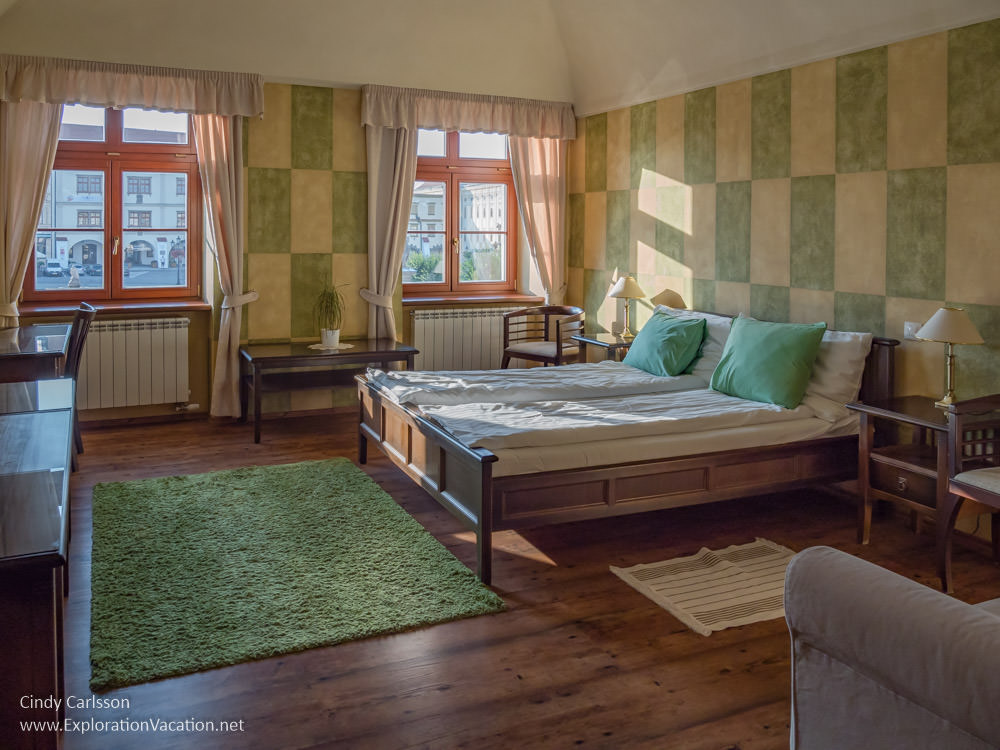
The hotel restaurant severed an excellent dinner and breakfast, both of which could be taken in the lovely dining room or on the veranda overlooking the square.
You can check your options and prices, read reviews, and make a reservation at Hotel La Fresca or any of the hotels in Kromeriz on TripAdvisor or Booking.com.
A special thank you to Zdeněk Urbanovský of the East-Moravian Tourist Authority for helping our small group of hot and tired ladies discover some the most beautiful and interesting spots in Kromeriz.
Interested in more Czech UNESCO World Heritage sites? My friend Rachel asked a few of us to put together some information on all of the sites outside Prague, including the sites I visited in Kromeriz and Lednice-Valtice. Check them out at Rachel’s Ruminations.
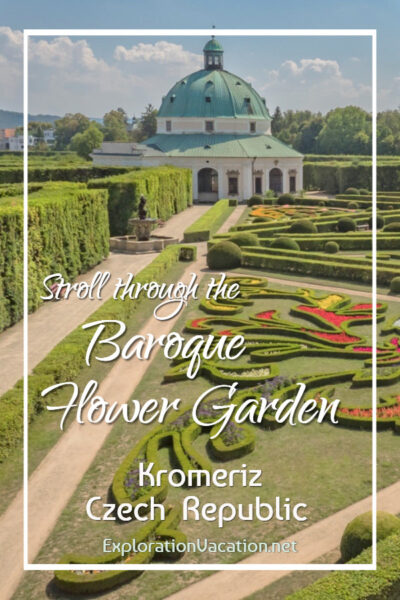





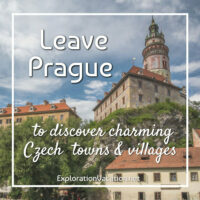



We only visited Prague during our time in the Czech Republic. Clearly, we need to make a return visit. Although we are personally horrendous at keeping plants alive, we love to visit gardens wherever we go. Based on your lovely photos, i’d say the gardens of Kromeriz Castle rival those of Versaille. I’ve pinned this to my Czech Republic Pinterest Board to remind me where to go.
There is a lot to see outside of Prague and fewer visitors — although Czechs and the neighbors have already discovered what seem like hidden gems to those of us from farther afield. The garden in Kromeriz is a lot smaller and simpler than Versaille, but it is one of the earliest examples of that type of garden. Versaille (which was largely completed in this style after the Kromeriz garden, although they were started about the same time) is sort of the ultimate expression of this type of garden design. Personally, I could probably keep the plants alive, but I’d never keep all those shrubs trimmed! Once through with the shears and that would be it! But I love the way it looks with all those straight edged hedges.
Though the photos do an incredible job at showing the beauty of the gardens, I am having a hard time picturing just how massive this place truly is! What an extraordinary and innovative design! Hoping that I get to visit one day!
It’s actually not that big. The whole area is less than 40 acres, so big, but not enormous. The fact that it is broken into all these smaller gardens makes it seem even smaller. I hope you do get there – it’s gorgeous and there is another “garden” here that is slightly larger, but completely different in that it is a Romantic landscape.
Lovely post highlighting the beauty of the Kromeriz Flower Garden. Thx much for this. I know very little about Czechia.
Thank you, Doreen. This really was a gorgeous garden, but there is lots of beautiful spots in Czechia. Lots of small towns with lovely spots!
Wow, that’s an incredible photo of the colonnaded loggia …having people in the shot really shows the scale of how massive it is! The gardens look beautiful but the architecture looks like its worth a visit as well – I love that rotunda.
Thank you! The loggia was fun to shoot – I just wish I had more time. I usually avoid people in my shots, but as you say they were needed to show how large it was. (So it was nice of them to walk through at just the right time!) The architecture is especially great because of the way it plays off against the plantings.Neither alone would be as interesting.